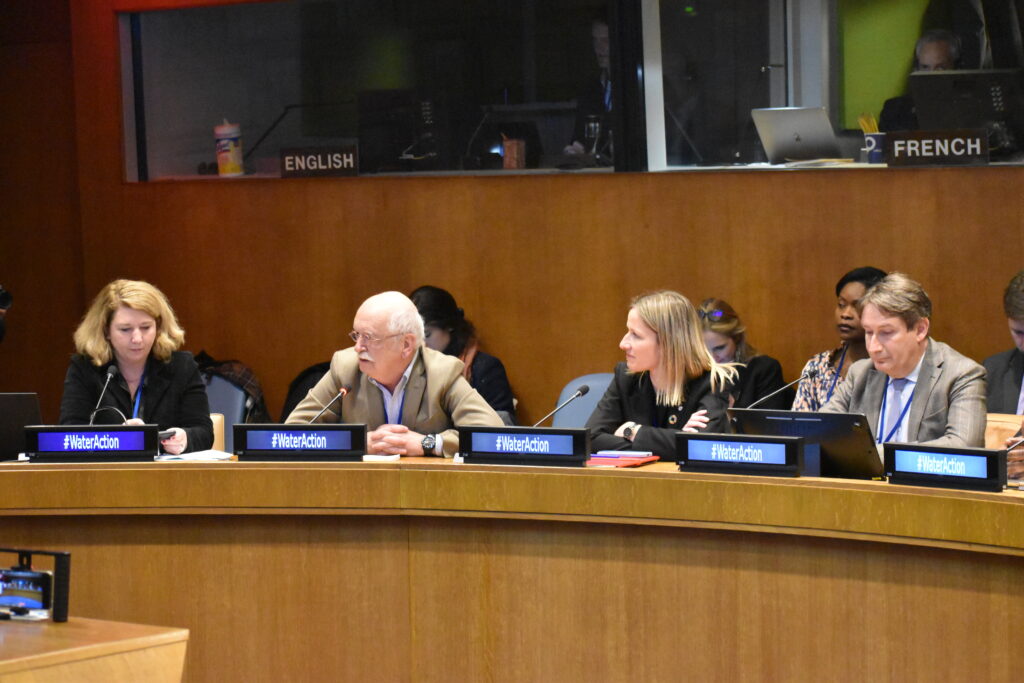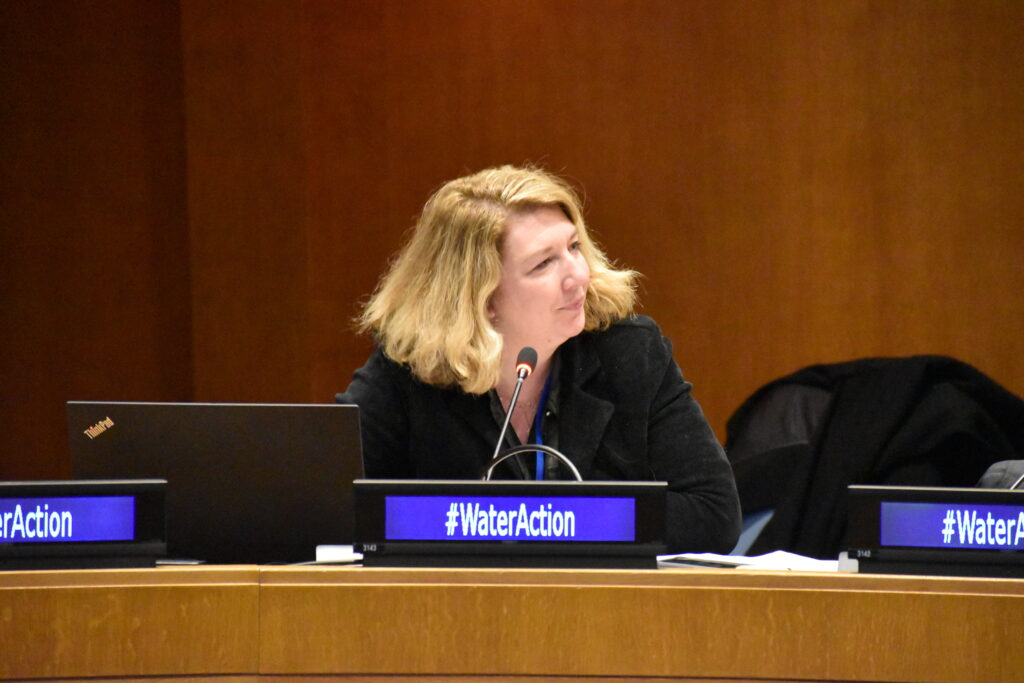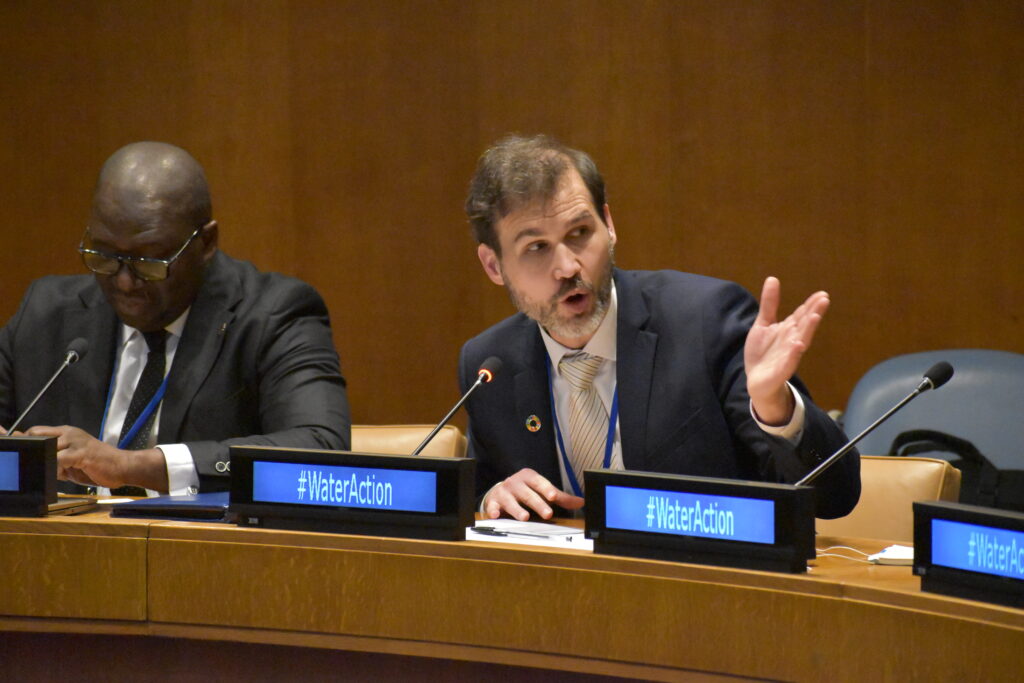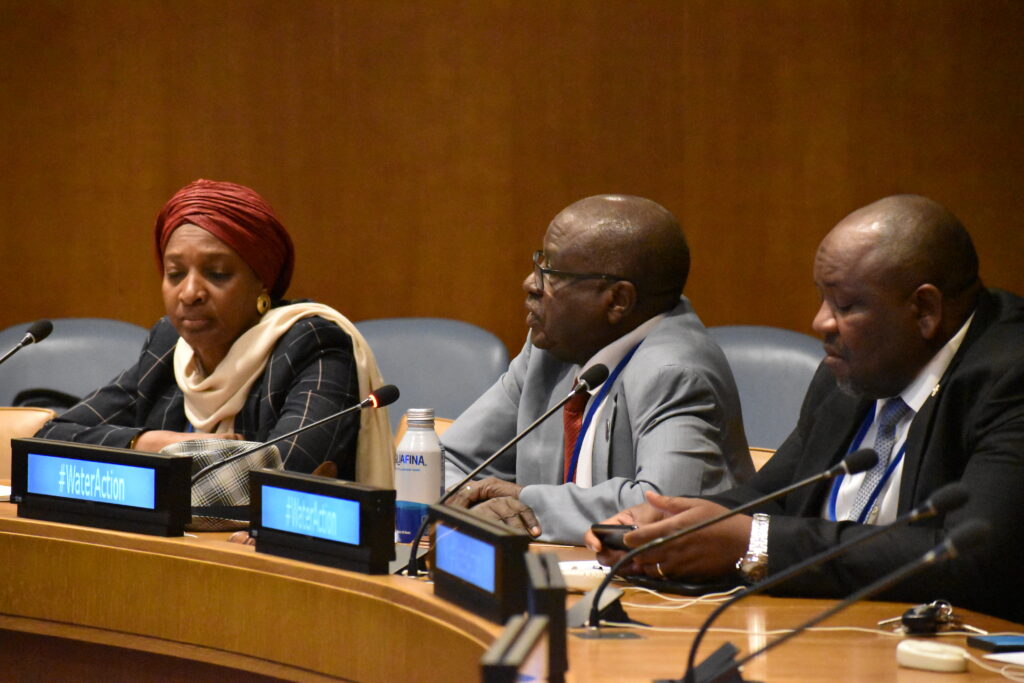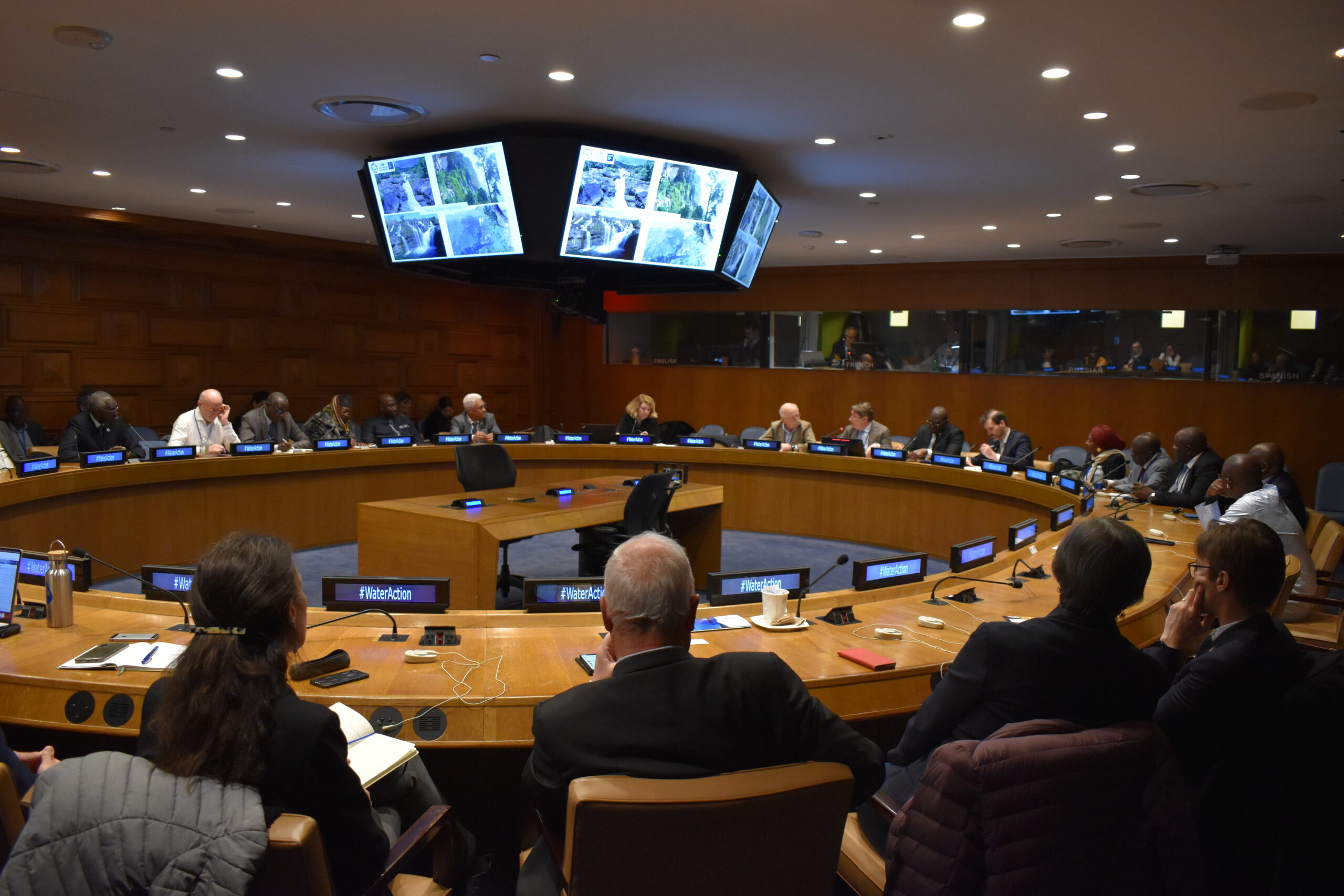The Fouta Djallon Highlands – the water tower of West Africa – are dying. These forested highlands in Guinea are home to the headwaters of some of West Africa’s largest rivers, e.g. the Senegal River, the Gambia River, and the Niger River. This jewel of nature provides water to a region of nearly 300 million people. Faced with the urgency of the accelerating degradation of the Fouta Djallon’s fragile ecosystems, The Bridge Tank, Initiatives for the Future of Great Rivers (IFGR) and the Senegal River Basin Development Organization (OMVS) joined forces to alert the international community and present a roadmap for action at the United Nations 2023 Water Conference in New York.
On March 24, The Bridge Tank, IFGR, and OMVS organized an official side event on “The Fouta Djallon: Visions & Actions to Safeguard the Water Tower of West Africa” with the official support of France and Guinea, represented respectively by Bérangère Couillard, Secretary of State for Ecology of France and by the Chief of Staff of Aly Seydouba Soumah, Minister of Energy, Hydraulics and Hydrocarbons, Republic of Guinea. The side event was organized in partnership with the French Development Agency (AFD), the French Water Partnership (PFE), the International Network of Basin Organizations (INBO), and the Geneva Water Hub.
Structure of the session:
- Opening addresses by Bérangère Couillard, Secretary of State for Ecology of France, Erik Orsenna, President, Initiatives for the Future of Great Rivers (IFGR) & member of the Académie française, and Joël Ruet, President, The Bridge Tank
- Presentation and assessment of the challenges facing the Fouta Djallon by Soufiana Dabo, Coordinator for Guinea, OMVS and Abderahim Bireme Hamid, Executive Secretary, Niger Basin Authority (NBA)
- The role of river basin organizations and ongoing actions by Lionel Goujon, Head of the Water and Sanitation Division of the French Development Agency (AFD)
- An action plan and a discussion on the solutions to safeguard the Fouta Djallon.
Rewatch the recording of the session on our YouTube channel (in French with English subtitles).
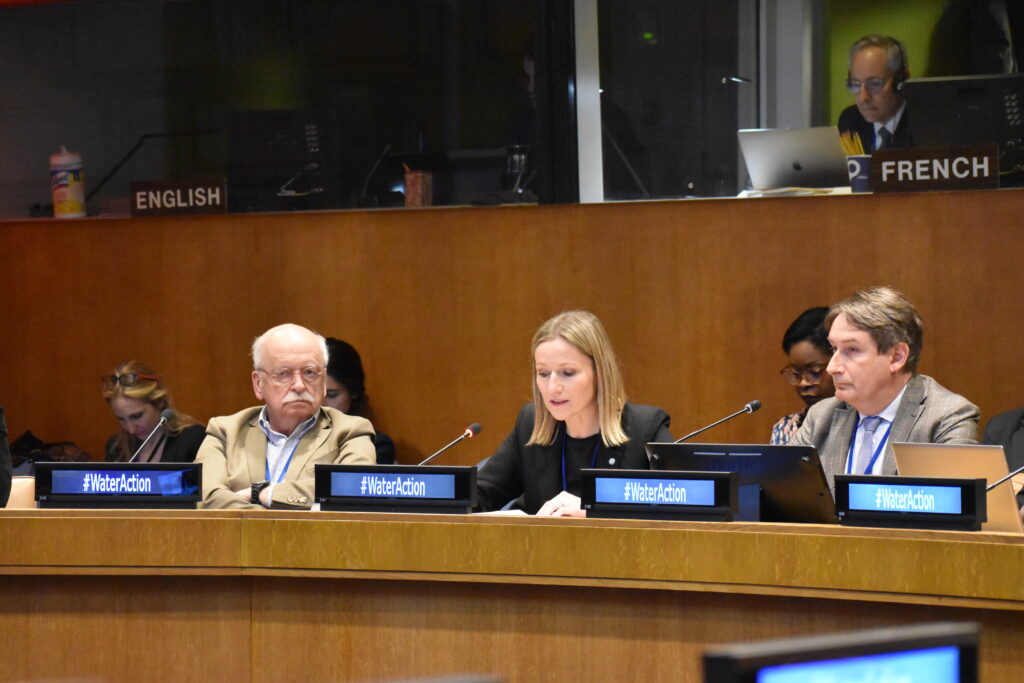
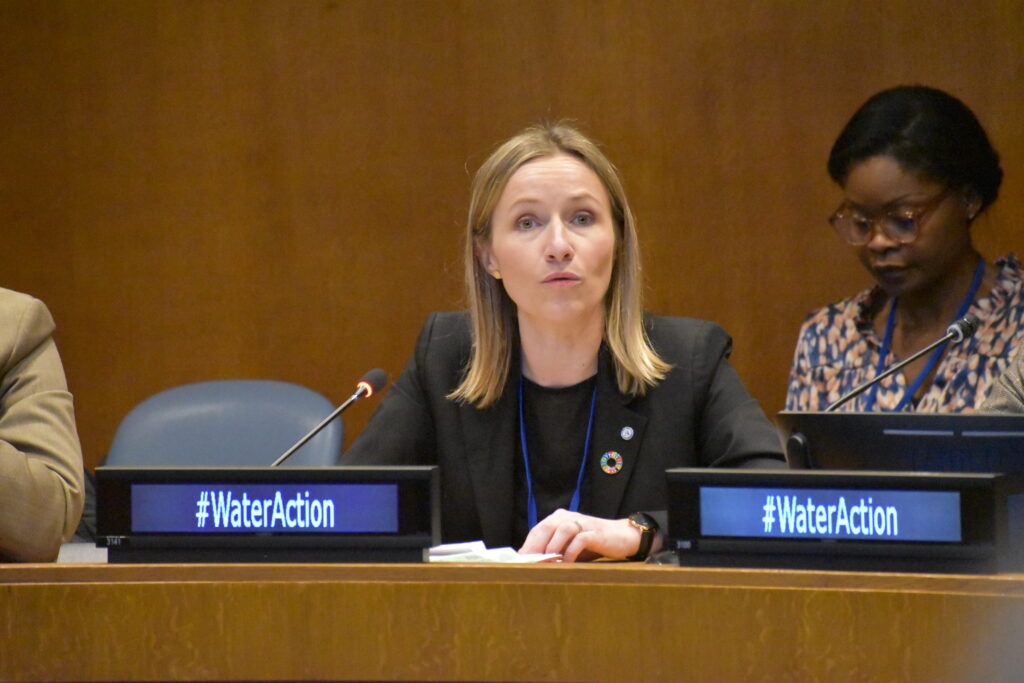
Opening addresses at the United Nations Headquarters
Confirming France’s support for this UN side event moderated by Sophie Gardette, Director, IFGR, Bérangère Couillard, Secretary of State for Ecology, France opened the session with an address to the panel.
In her speech, Ms. Couillard introduced the importance of preserving the Fouta Djallon Highlands and their unique ecosystem in order to protect West Africa’s largest rivers, emphasizing at the same time the interdependence between the preservation of ecosystems and the availability of water, both in quantity and quality. Secretary of State Couillard also praised the work of the region’s river basin organizations, particularly OMVS, and their role in integrated water resources management at the level of transboundary basins.
This was an opportunity to remind the audience of France’s role in the development and promotion of Integrated Water Resources Management (IWRM) and to encourage a multi-sectoral approach, reconciling all stakeholders drawing on the resources of the Fouta Djallon and impacting its ecosystems. In conclusion, Ms. Couillard recalled the importance of the Water Convention and praised the pioneering role of Senegal and Chad, which were some of the first countries outside Europe to join the Convention.
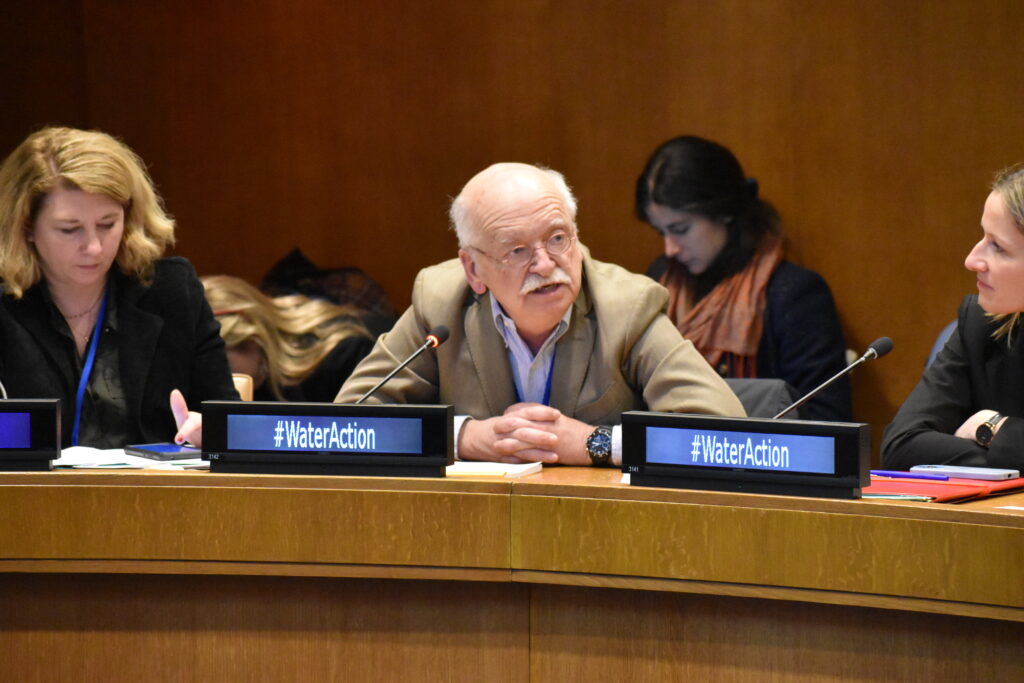
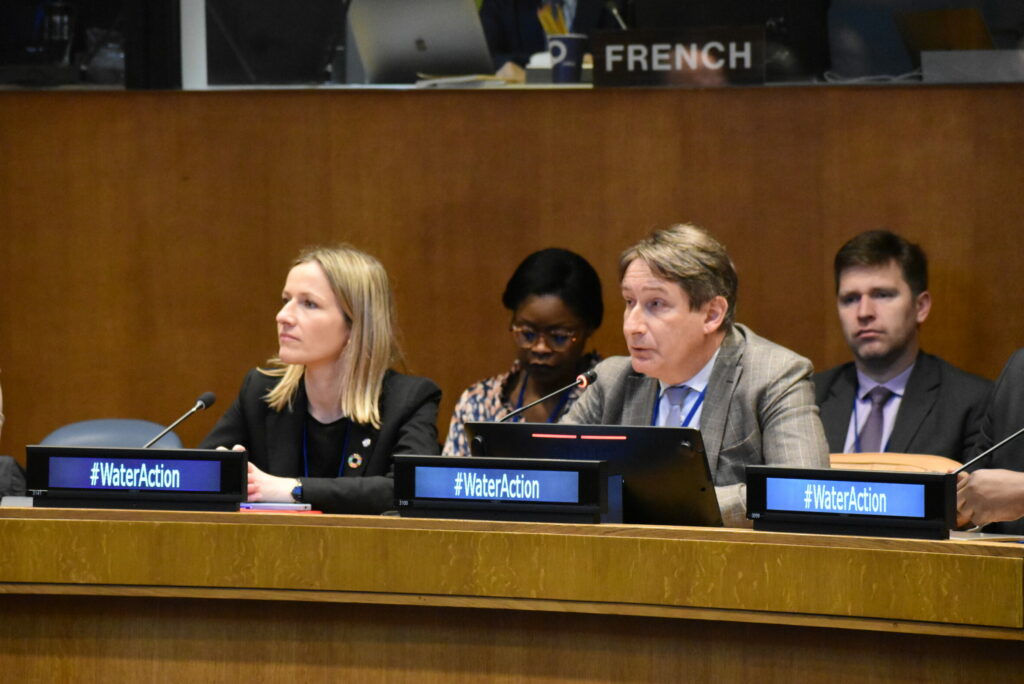
Erik Orsenna – The water cycle and the life cycle
As co-host and co-organizer of this event, Erik Orsenna, President, Initiatives fur the Future of Great Rivers (IFGR) & member of the Académie française, issued a call to action to preserve the forest and river ecosystems of Fouta Djallon. Faced with the complexity and elusive diversity of water, “most essential of all resources,” Mr. Orsenna stressed the importance of using concrete characters and stories to convey the challenges of water resources management and preservation.
Rivers, and in particular the great rivers Senegal, Gambia, and Niger in the case of Fouta Djallon, form this unity of life, these living characters whose stories can be told. Quoting one of his predecessors at the French Academy, Jacques-Yves Cousteau, Mr. Orsenna thus noted that “the water cycle and the life cycle are one.” Biological health, economic health and social health are thus closely intertwined.
This unity of the cycle of water and the cycle of life is also found in Africa: 60% of the drinking water consumed in Dakar and 100% of that consumed in Nouakchott come from the Senegal River. Erik Orsenna also got to experience another theorem when he visited the shores of Lake Chad in Niger: “the less water there is in Lake Chad, the more terrorists there are.” “And it is for these two reasons that we decided to raise the alarm on the Fouta because the Fouta is the source of all this life in West Africa,” Erik Orsenna concluded.
Joël Ruet – Experiences from the field
Offering an account of his trip to the Fouta Djallon with Hamed Semega, former High Commissioner of the OMVS, Joël Ruet, President, The Bridge Tank & economist at the Interdisciplinary Institute of Innovation i3t, CNRS, began his address by paying tribute to Mr. Semega, with whom he went on this field trip and who was the first high commissioner to visit the sources of the Senegal River. The field mission revealed that the men and women, local populations living near the springs, were also suffering from the lack of water. Where there are only picturesque puddles left today, 10 or 15 years ago, these same pools were big enough for an adult to drown in. “It is now a matter of turning a vicious circle into a virtuous circle,” Joel Ruet said, adding that “the solutions are with the people, with the local communities, and it is our moral and human responsibility as an international community to help and support them in their initiatives.”
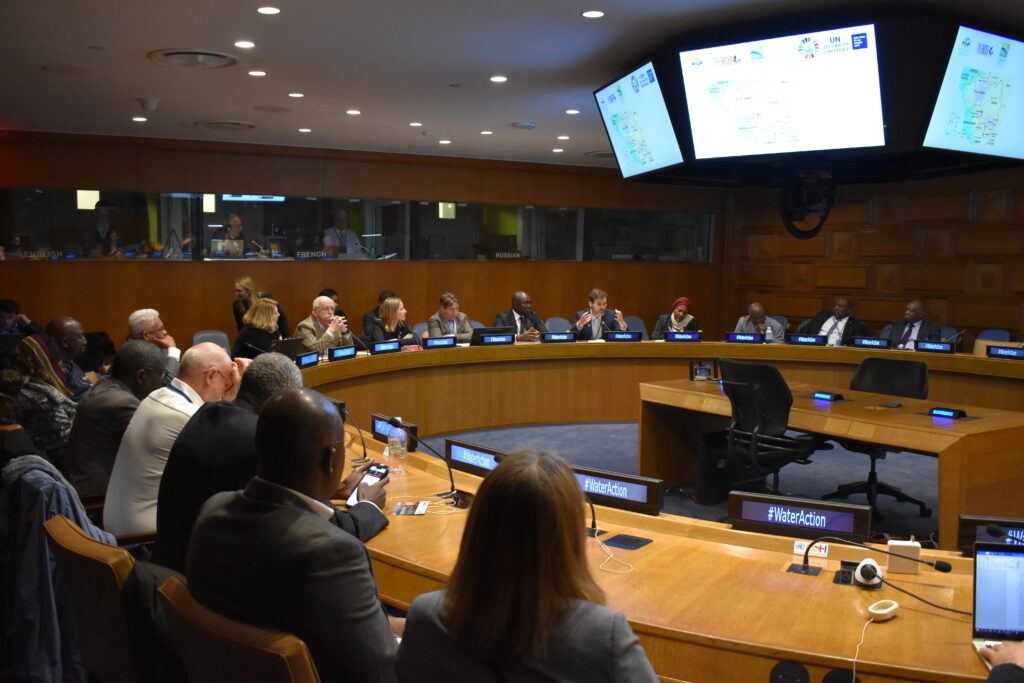
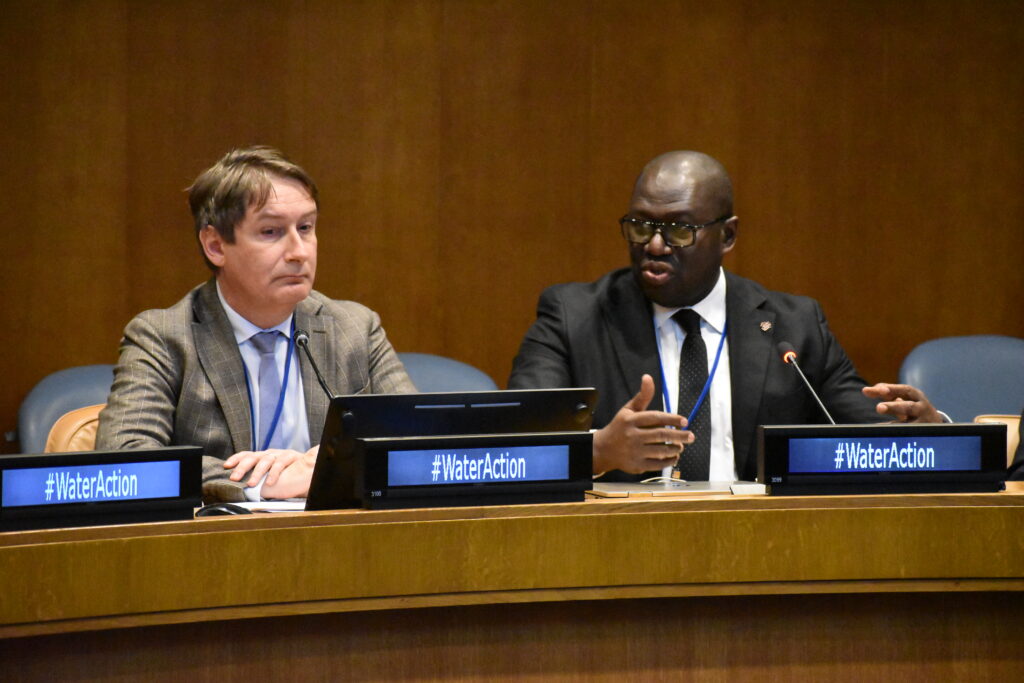
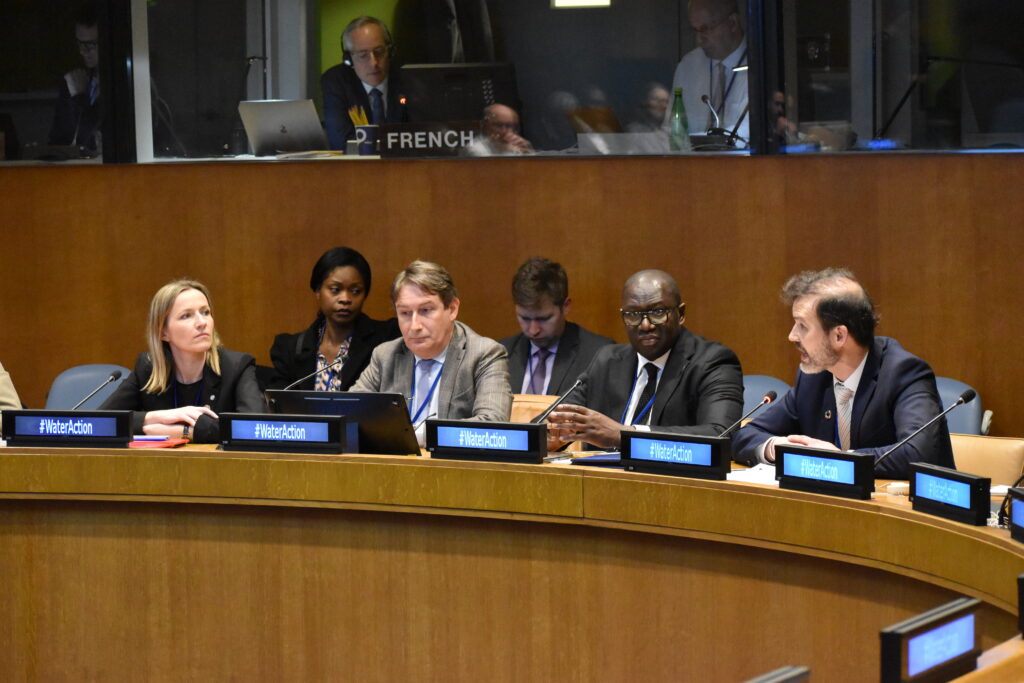
An agonizing Fouta Djallon
Soufiana Dabo, Coordinator for Guinea, OMVS, described the context of the Fouta Djallon before recalling the challenges and threats facing these highlands which are home to the sources of the Senegal River, the Gambia River, the Niger River and other smaller rivers. This mountainous territory in the north of the Republic of Guinea and extending towards Senegal, Mali and Guinea-Bissau is found at altitudes ranging between a little over 500 and 1515 meters, culminating on Mount Loura. The unique ecosystem of Fouta Djallon is now endangered and many endemic species, both fauna and flora, are growing rare.
The region is inhabited by sedentary farmers and herders whose activities coexist. However, demographic pressure has driven people closer to water sources in order to meet the growing need for water for agriculture and for the daily consumption of both communities and livestock. This growing pressure on sources has led to a decrease in the available water quantity but also to the degradation of riverbanks, impacting both Guinea upstream and the countries and 300 million people living downstream.
Abderahim Bireme Hamid, Executive Secretary, Niger Basin Authority (NBA), also noted additional degradation on the highlands inflicted by man. These include, for example, the production of baked bricks, excessive logging, and mining, particularly traditional gold mining.
The reduction of vegetation cover and the degradation of soils – a consequence of overgrazing and agricultural practices inappropriate to the demographic context, such as slash-and-burn agriculture and the reduction of the time these lands lie fallow have also contributed to the fragility of Fouta Djallon. These unsustainable agricultural and forestry practices reduce the forest cover and dry out the soil, threatening the stability of the ecosystems of the Fouta Djallon. These dynamics accelerate desertification and the silting up of waterways and of their springs, thereby also reducing the absorption capacity of soils. The threat is also environmental, since climate change affects the rainfall and the particular microclimate of Fouta Djallon, with temperatures constantly rising.
“Together we must mobilize our actions, efforts, awareness, and knowledge around what needs to be done now to restore this ecosystem […], to raise people’s awareness but also to allow them to continue their activities without being in conflict with nature,” Mr. Dabo concluded.
“If we do not act proactively to change the situation and to revive the Fouta Djallon highlands, the risk will impact all of these countries (the 9 member states of the NBA) and all of these populations in Africa,” Mr. Hamid concluded.
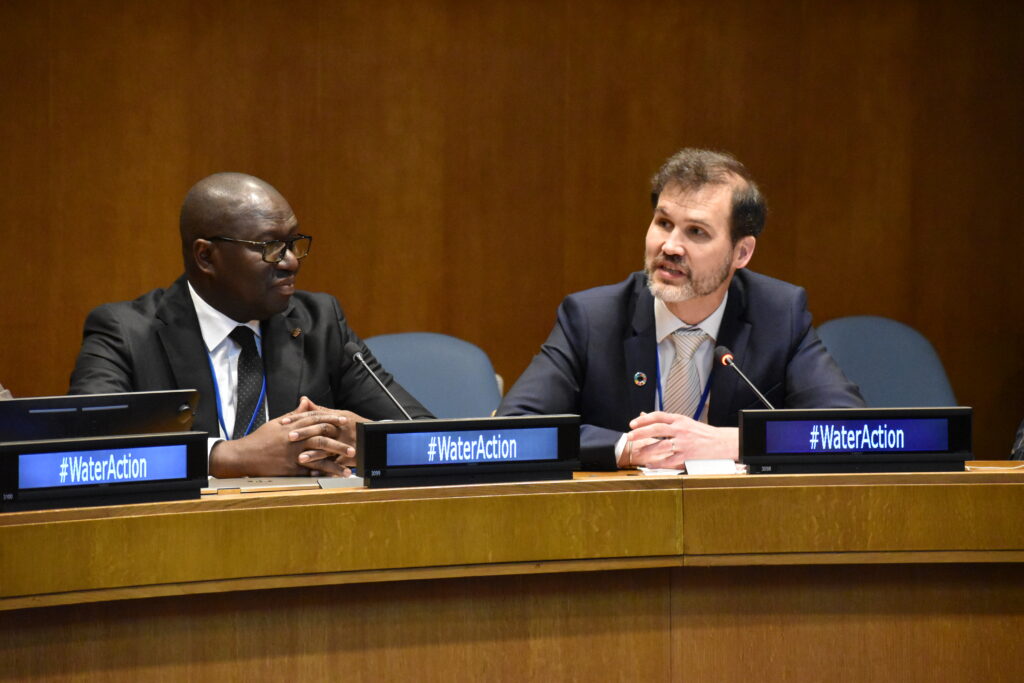
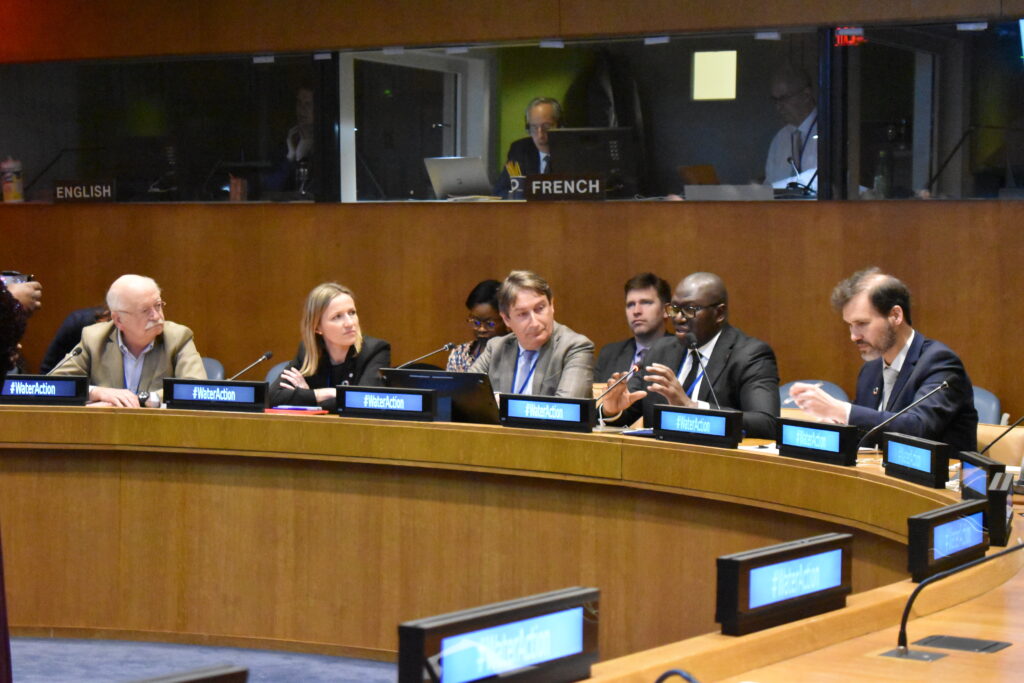
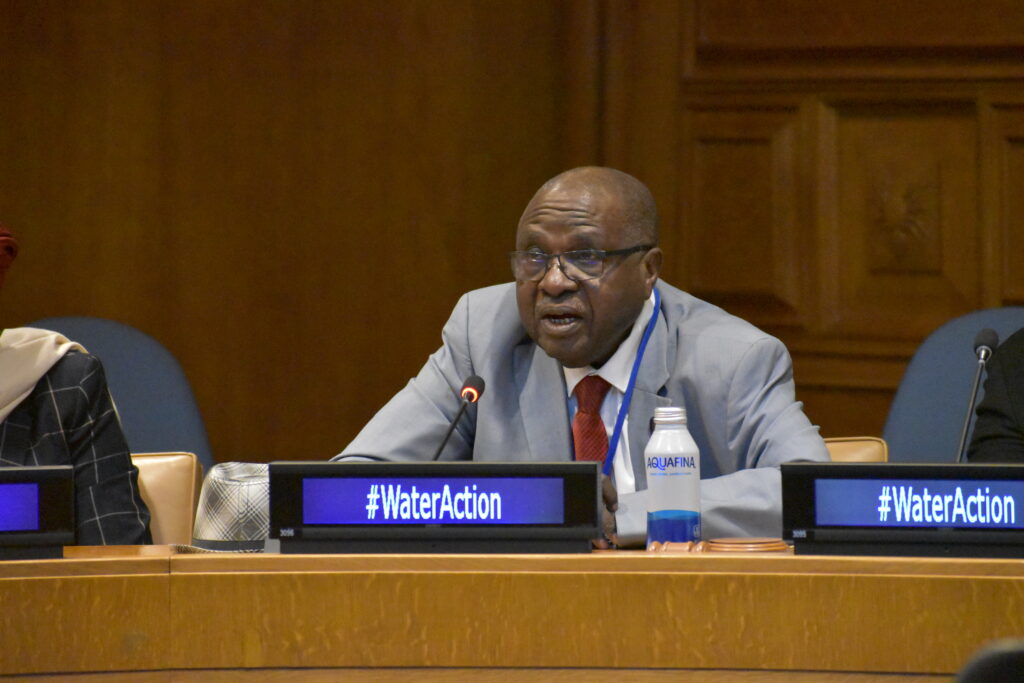
River basin organizations at the heart of preservation efforts
Lionel Goujon, Head of the Water and Sanitation Division of the French Development Agency (AFD) presented the existing preservation and sustainable management initiatives as well as the actions already carried out in the field by the AFD. These have been developed and carried out in partnership with the various basin organizations of the region. The presence of senior officials of these basin organizations, with Mr. Soufiana Dabo for the OMVS, an organization that AFD has been supporting for about 40 years, and Mr. Abderahim Bireme Hamid for the NBA, with which AFD has been collaborating for about 20 years, illustrated the investment and the central role of these organizations in the management of water resources and the preservation of the region’s ecosystems.
It is about avoiding the tragedy of the commons and the unfolding tragedy of Fouta Djallon, Mr. Goujon stated, referencing Elinor Ostrom, Nobel Prize in Economics in 2009. The challenges in the conservation efforts are numerous: lack of knowledge about the declining resource and its ecosystem, lack of measurements, and lack of data on the consequences of ongoing hydrological changes, as well as the need for new technologies and human resources and devices to maintain measurement networks.
AFD’s action in partnership with basin organizations is structured around projects such as the SCREEN project with OMVS, a project of altimetric measurements with satellite technologies in collaboration with French actors like CNR, IRD, BRL, and CNES. The DYNOBA project for the revitalization of transboundary basin organizations in Africa encourages the sharing of experiences between basin organizations. The Fouta Djallon could be a field of application of this exchange. AFD is also currently working on a project to support Guinea’s national meteorological services to strengthen national meteorology and produce more reliable data.
“There are several levels to work on: institutional, international, national, and local with the populations in order to have a beneficial impact on this region,” Mr. Goujon concluded.
An action plan for the Fouta Djallon
The objective of this side event was not only to alert the international community on the alarming situation of a dying Fouta Djallon but also to present an action plan and the key avenues of action for the preservation of the highlands. Joel Ruet, President, The Bridge Tank & economist at the Interdisciplinary Institute of Innovation i3t, CNRS presented some essential features of such an action plan.
- Supporting and mobilizing local communities by establishing a catalogue and an academy of durable best practices, combining both traditional and modern agricultural and ecosystem preservation methods, e.g. resilient agroforestry, to raise awareness and train local populations;
- Fostering local and regional research and innovation to increase knowledge and data of the Fouta Djallon’s resources and ecosystems. This will be achieved by establishing and supporting incubators of technological startups, supporting academic research projects, local environmental engineering, and the development of nature-based solutions;
- Fostering political will and regional cooperation by creating an assembly of West African states, RBOs, and multilateral organizations, backed by the international community, for the Fouta Djallon to develop a regional cooperation framework around this common resource and ensure social, societal, and environmental sustainability in the highlands and across the region;
- Mobilising new green finance mechanisms in support of the Fouta Djallon by establishing a green-blue bond dedicated for the preservation of biodiversity and the development of the highlands with international support.
In the continuity of the actions already implemented, concerted action across the sub-region to preserve the Fouta Djallon will have to involve basin organizations. The issue of governance was also highlighted by Lionel Goujon, who advocated for a governance at different levels, involving basin organizations, states and sub-regional economic communities. “There is a need to create coalitions and cooperation platforms today,” Joël Ruet stressed, which will necessarily involve local communities, in order to determine which traditional methods need to evolve and what traditional knowledge can be mobilized as more sustainable and resilient farming or agroforestry methods. According to Soufiana Dabo, the priority is to adapt and rethink existing solutions.
A tool which will play an important role in this process is the Fouta Djallon Observatory set up by the OMVS. According to Mr. Dabo, it will allow to observe, analyze and act in the Fouta Djallon. Soufiana Dabo took the opportunity to call for support of the Observatory as a center of research, reflection and data collection necessary for the evolution of the highlands. This evolution aims at accompanying the communities in their transition, either towards other activities that will have less impact on the ecosystem of the highlands, or to modernize current practices and activities undertaken by local populations. Within the framework of its IWRM programs, OMVS has launched the first initiatives in this direction, including agricultural development projects and the establishment of irrigated and fenced areas to settle the population. The rehabilitation of fish reserves hopes to turn fishing into an alternative source of income.
“We must not oppose socio-economic and human development to nature and the environment,” Joël Ruet insisted.
Finally, a last community that needs to be mobilized are the young graduates of the region’s universities. Mr. Ruet emphasized the importance of local technological entrepreneurship. The support of incubators of young local entrepreneurs returning to the field after their studies would provide the human resources to sustain the measurement and data collection systems necessary for all preservation efforts. This data can also be mobilized for sustainable finance mechanisms that enable, according to Mr. Ruet, “transformational changes going to scale.”
This session is part of The Bridge Tank’s long-standing commitment to the preservation of the Fouta Djallon. At the World Water Forum in Dakar in March 2022, The Bridge Tank and IFGR had already co-organized a session on the issue of safeguarding the Fouta Djalon highlands, in partnership with OMVS and Organisation pour la Mise en Valeur du Fleuve Gambie (OMVG). Previously, Joel Ruet, President, The Bridge Tank, had also participated in a field mission in the Fouta Djalon led by our board member Hamed Semega, then High Commissioner of OMVS.
